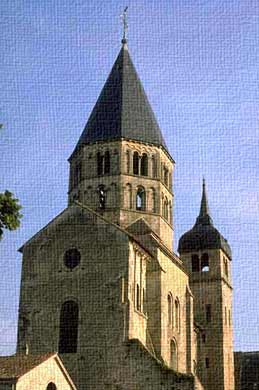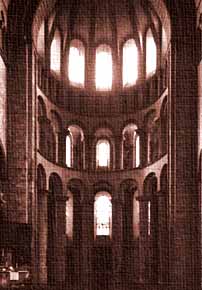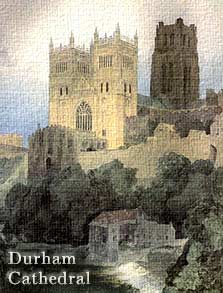|
 Sadly,
much of the great developments of the Romanesque period are overshadowed
by later works. When we think of the Norman style today, we think more
of fortified walls and castles. But, the careful student will be greatly
rewarded by turning attention toward the abbeys and monasteries of the
pre-Gothic age. The needs of the large monastic orders for housing,
industry and religious service ignited a strong demand for new building
skills and techniques. Although they do not receive as much public attention
as the grand churches and cathedrals, many of the Cistercian and Benedictine
abbeys still exist. Most sites are accessible to visitors willing to
go a little out of their way to seek them out. Sadly,
much of the great developments of the Romanesque period are overshadowed
by later works. When we think of the Norman style today, we think more
of fortified walls and castles. But, the careful student will be greatly
rewarded by turning attention toward the abbeys and monasteries of the
pre-Gothic age. The needs of the large monastic orders for housing,
industry and religious service ignited a strong demand for new building
skills and techniques. Although they do not receive as much public attention
as the grand churches and cathedrals, many of the Cistercian and Benedictine
abbeys still exist. Most sites are accessible to visitors willing to
go a little out of their way to seek them out.

The tower of the South Transept at
Cluny.
This impressive feature is all which remains
of the once grand Romanesque abbey.
 Many
of the churches and cathedrals constructed during the Romanesque period were either
greatly modified or completely replaced in succeeding centuries. In certain locations,
such as Durham in England we can see a predominantly Romanesque form with fine Gothic
additions. More often, the casual visitor is hard put to determine where the two styles
begin and end at the more prominent sites. Many
of the churches and cathedrals constructed during the Romanesque period were either
greatly modified or completely replaced in succeeding centuries. In certain locations,
such as Durham in England we can see a predominantly Romanesque form with fine Gothic
additions. More often, the casual visitor is hard put to determine where the two styles
begin and end at the more prominent sites.
 The
pre-Gothic achievements have been obscured through history as well. Much of the
credit for seemingly revolutionary innovations has been attributed solely to the craftsmen
of the Gothic age. The apparent absence of evolving styles leading to the impressive
works of the twelfth and thirteenth centuries has even lead to speculation
of outside influence in their construction. Some have proposed that ancient building
secrets were discovered in the Holy Land, and brought back to Europe by crusading
knights. However, less romantic origins may be uncovered with dedicated exploration
and an aware eye. The
pre-Gothic achievements have been obscured through history as well. Much of the
credit for seemingly revolutionary innovations has been attributed solely to the craftsmen
of the Gothic age. The apparent absence of evolving styles leading to the impressive
works of the twelfth and thirteenth centuries has even lead to speculation
of outside influence in their construction. Some have proposed that ancient building
secrets were discovered in the Holy Land, and brought back to Europe by crusading
knights. However, less romantic origins may be uncovered with dedicated exploration
and an aware eye.
 With
the final collapse of the Roman empire, all architectural development ceased in
Europe. All construction was determined by practical need and primarily limited to
houses of worship. Churches of this time were small, simple structures and it is not
until the eighth century that the influence of the Byzantine empire inspires a slow
change from the south. With
the final collapse of the Roman empire, all architectural development ceased in
Europe. All construction was determined by practical need and primarily limited to
houses of worship. Churches of this time were small, simple structures and it is not
until the eighth century that the influence of the Byzantine empire inspires a slow
change from the south.
|
 The
pre-Romanesque period, the Carolingian, was itself a period of great innovation,
initiated by the rise of Charles the Great or Charlemagne in the late eighth and
early ninth centuries. Victories across western Europe and a consolidation of
diverse regions made Charles the most powerful ruler since the collapse of Rome. The
pre-Romanesque period, the Carolingian, was itself a period of great innovation,
initiated by the rise of Charles the Great or Charlemagne in the late eighth and
early ninth centuries. Victories across western Europe and a consolidation of
diverse regions made Charles the most powerful ruler since the collapse of Rome.
 Pope
Leo's declaration of Charlemagne as '...peace-giving emperor of
the Romans...' on Christmas day in 800, marks the first glimmer of
dawn for the Dark Age of European history. With energetic intent,
the young emperor initiated a cultural renovation of the new realm,
radiating from his capital in Aachen. Architecture benefited greatly
within this period and master builders were accorded a deserving respect.
Among the significant contributions of this era are westworks and
bell towers, features which both the Romanesque and Gothic ages evolved
upon elaborately. Pope
Leo's declaration of Charlemagne as '...peace-giving emperor of
the Romans...' on Christmas day in 800, marks the first glimmer of
dawn for the Dark Age of European history. With energetic intent,
the young emperor initiated a cultural renovation of the new realm,
radiating from his capital in Aachen. Architecture benefited greatly
within this period and master builders were accorded a deserving respect.
Among the significant contributions of this era are westworks and
bell towers, features which both the Romanesque and Gothic ages evolved
upon elaborately.
 It
is important to bear in mind that all European architecture prior to the Renaissance
has been very broadly categorized. There are a wide range of distinctions in form
and style spread across the geography of Europe and the expanse of the centuries.
Even the names we accept without question today, Romanesque and Gothic, were applied
hundreds of years after the periods they define. It
is important to bear in mind that all European architecture prior to the Renaissance
has been very broadly categorized. There are a wide range of distinctions in form
and style spread across the geography of Europe and the expanse of the centuries.
Even the names we accept without question today, Romanesque and Gothic, were applied
hundreds of years after the periods they define.

Interior of Tournay cathedral,
Belgium,
Twelfth century Romanesque.
 The
era in which the Romanesque The
era in which the Romanesque structures arose was a time of great significance
for European culture. Hundreds of years of chaos were passing as new orders began
to take shape across the continent. As the first millennium drew to a close, the
church had become the dominant influence and promoter of art and culture. Beginning
as isolated outposts, the monasteries would eventually bring civilization and
education to the far reaches of Europe. It is a fascinating chapter of history
to study, and architecture is a central component of that story. Learning to discern
the distinctions and styles of each period will return many unexpected rewards
to the dedicated student. The structures of the Romanesque and Gothic eras are
cultural legacies awaiting just such exploration.
|






